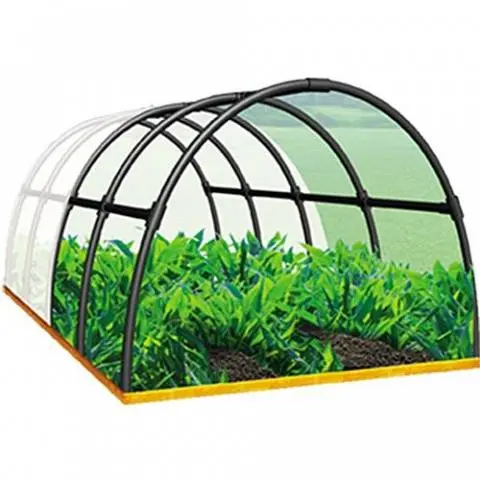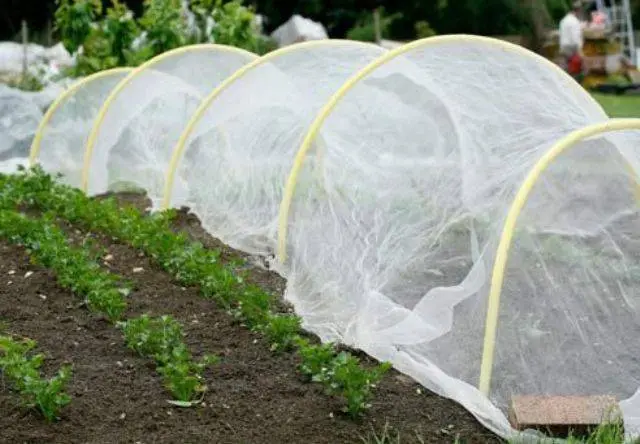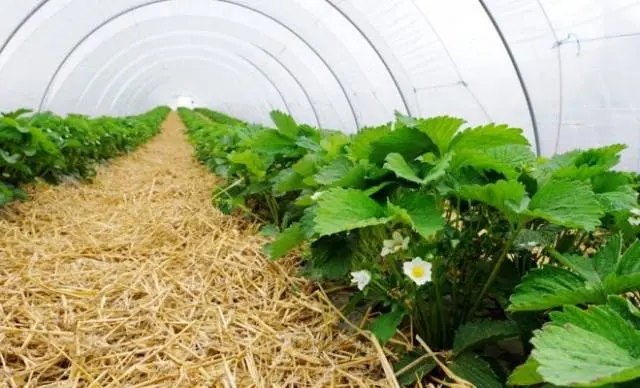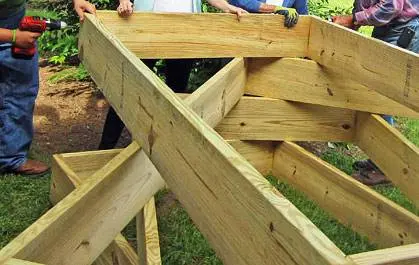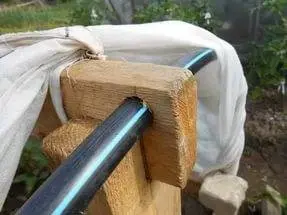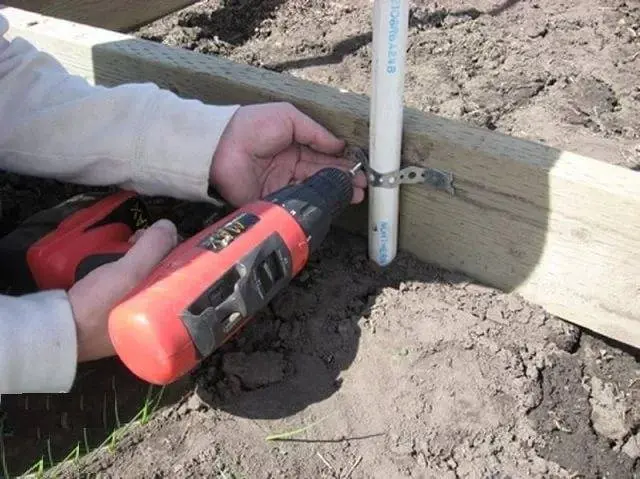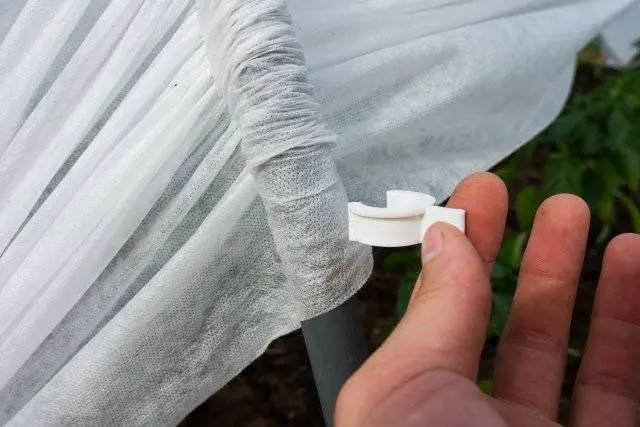Contents
The arc greenhouse is in great demand, as it is suitable for greenhouses and open ground. The factory design is made in lengths from 4 to 10 m, which allows you to choose the right model for the size of the site. For home gardening, greenhouses made of arcs with covering material can be bought ready-made or made independently.
The design of the arc greenhouse and its purpose
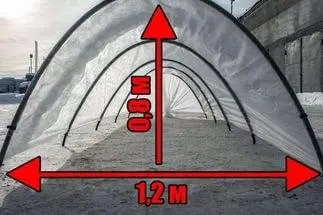
A greenhouse made of arcs is an arched frame covered with a special material. As a shelter, a non-woven fabric or film is used. The distance from the ground to the top of the arc is considered the height of the greenhouse. This figure varies from 0,5 to 1,3 m, depending on the type of plants grown. The optimal width of the arc greenhouse is taken from 0,6 to 1,2 m. The length of the structure depends on the distance between the arcs, as well as their number. Factory-made models are in great demand, the length of which is 4,6 and 8 m. When making a shelter for a garden bed from arcs with your own hands, you can make any length. However, a design that is too large is less stable in the wind, especially if it is made on PVC arcs.

These photos show the purposes for which arc greenhouses are used:
- In cold areas, heat-loving crops are grown under cover for a whole season. The dimensions of the greenhouses are selected taking into account the fact that the plants will grow and they should have enough free space. The covering material on the arcs is fixed with special clips so that the canvas can be easily lifted for easy access to the garden.

- Temporary shelter is used to adapt the planted seedlings to outdoor temperature. The canvas protects plants from night frosts and the scorching daytime sun. For these purposes, a prefabricated greenhouse is suitable, which is easy to install on the street or in a greenhouse. After adapting the seedlings, the shelter is dismantled.

- On the street and inside the greenhouse, greenhouses are used for growing radishes, seedlings of cold-resistant crops, as well as early green salads.

- Prefabricated shelters are convenient for temporary installation on beds with sown seeds. For example, grains of carrots or parsnips germinate for a long time, and under temporary shelter, the process is accelerated twice.

- The use of a prefabricated greenhouse helps save plantings from a massive pest infestation. The timing of their appearance for each culture is different, so collapsible shelters are used periodically, but the whole season.

- Ripe strawberries are loved not only by children, but also by birds. Prefabricated greenhouses installed above the garden bed help to save the crop. To provide air access and enable bees to pollinate strawberry flowers, the ends of the frame are only half closed.

Factory greenhouses are assembled from arcs with covering material quickly and easily. Pegs are included. They are simply driven into the ground and arcs are attached to them. The covering sheet is fixed with plastic clips. Some models are made with arcs sewn into the non-woven fabric. Assembling such a greenhouse, in general, is not difficult. It is enough to stretch the structure along the garden bed and drive the arcs with pegs into the ground.
Arches and other elements for factory-made greenhouses
A factory greenhouse made of arcs is completed with arches of a certain size and the required number, which depends on the dimensions of the structure. However, each item can be purchased separately, not as a set. This allows you to make a shelter of suitable sizes for your site.
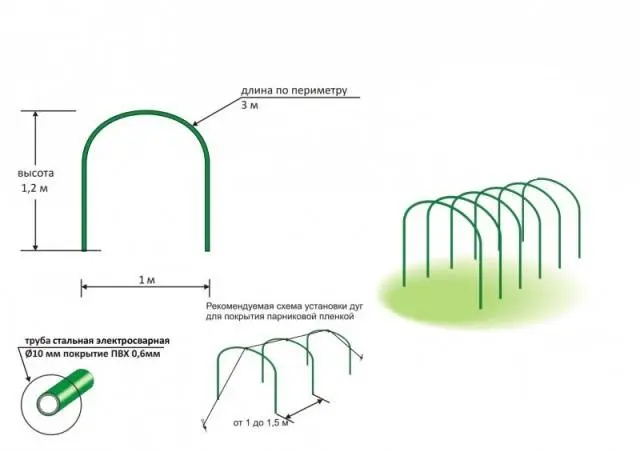
Separately sold arcs for a factory-made greenhouse are made of the following material:
- Arcs made of metal are made of elastic wire with a cross section of 5–6 mm, covered with a PVC sheath.
- Another type of metal arcs for a greenhouse is an arch made of steel tubes with a cross section of 10–12 mm. For protection against corrosion, the arcs are covered with a PVC sheath.
- The cheapest are plastic arcs for a greenhouse, made from a pipe with a diameter of 20–25 mm.
To determine what is better to choose arcs from, it is necessary to consider the property of each material. Metal is a durable and reliable material. PVC sheath protects the arch from corrosion, which significantly increases its service life. Metal arcs are easily stuck into the ground, and you don’t have to worry about them that the edge will bend during installation.
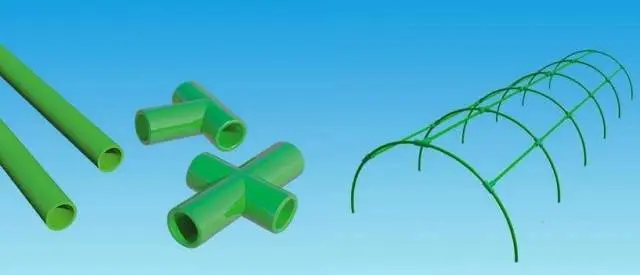
The plastic pipe is quite flexible. This allows you to give the arch the necessary width and height, guided by the dimensions of the beds, as well as the growth of plants. It is difficult to stick a plastic pipe into the ground, as there is a risk of breaking it. Such arcs are mounted on pieces of reinforcement driven into the ground or sold prefabricated pegs.
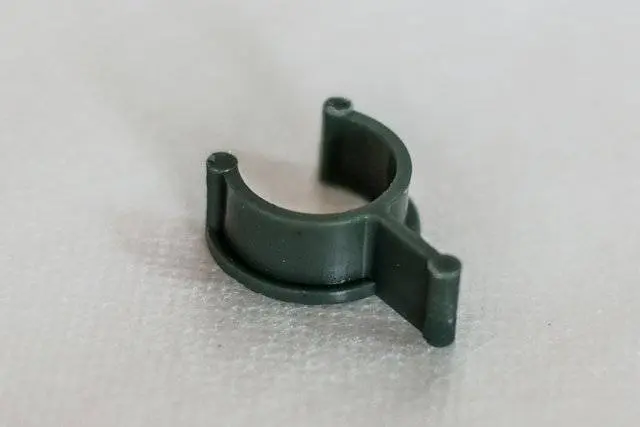
The covering sheet to the arcs is fixed with plastic clips. They can similarly be purchased separately according to the number of arcs purchased. To attach the covering sheet to the ground, special pegs with clamping rings are purchased.
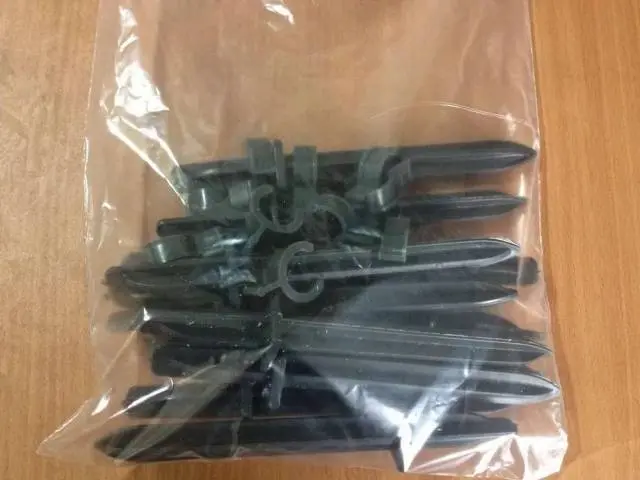
Overview of popular models of prefabricated greenhouses
A ready-made greenhouse from prefabricated arcs is designed for certain dimensions of the beds. The kit comes with frame and fasteners. Many sets are completed with a canvas according to the size of the greenhouse. It is impossible to change the distance between the arcs in a finished greenhouse on your own, especially if they are sewn into the canvas. Now we will look at a photo and a brief description of popular models of factory greenhouses.
Dayas
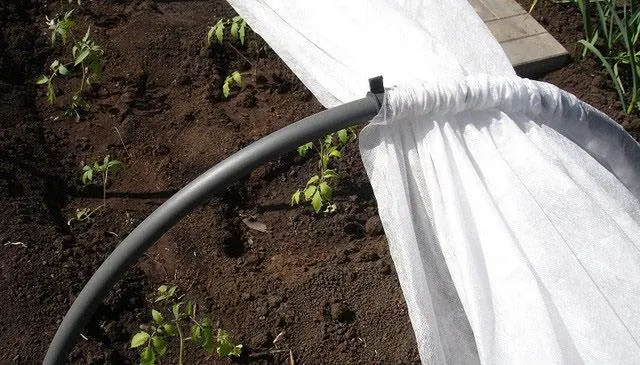
The design of the shelter for the beds “Dayas” consists of plastic arches sewn into the canvas. Arcs 2 m long are made of a pipe with a section of 20 mm. To install the arches, a peg 200 mm long is inserted at the end of each pipe. It is enough to stick them into the ground and compact them well. The frame is made up of sections. This design allows you to install a shelter 4 or 6 m long. In the assembled state, the width of the greenhouse is 1,2 m, and the height is 0,7 m. Convenient access to plants is provided from the sides of the greenhouse by raising the canvas up along the arcs.
The 2,1 m wide covering sheet included in the kit is sewn to plastic arcs and easily moves along them. Additional plastic clips are supplied. During watering the beds, they fix the raised canvas on the arcs, preventing it from falling.
The video shows the Dayas greenhouse:
Agronomist

This model of shelter for beds is made of plastic arches, for which a pipe with a section of 20 mm was used. A peg 200 mm long is inserted into the end of each pipe. The arches are made 2 m long. The height of the assembled structure can be in the range of 0,7–0,9 m. The sections allow you to make a shelter 4 or 6 m long. Agrotex-42 is used as a covering sheet.
early maturing
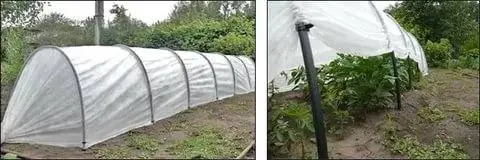
The prefabricated type of greenhouse is produced by several types of models that differ in the size of the arcs: the width is 1 or 1,1 m, the length of the arches is 3 or 5 m, the height of the finished structure is 1,2 or 1,6 m. The arcs are made of an elastic metal rod, covered protective polymer shell. The product set includes 4 or 6 arches, depending on the dimensions of the greenhouse, 1 or 3 cross bars, clips, pegs and fixing rings for the canvas. The frame is assembled quickly, by installing arches into the ground. Between themselves, the arcs are connected by a crossbar.
Hawk
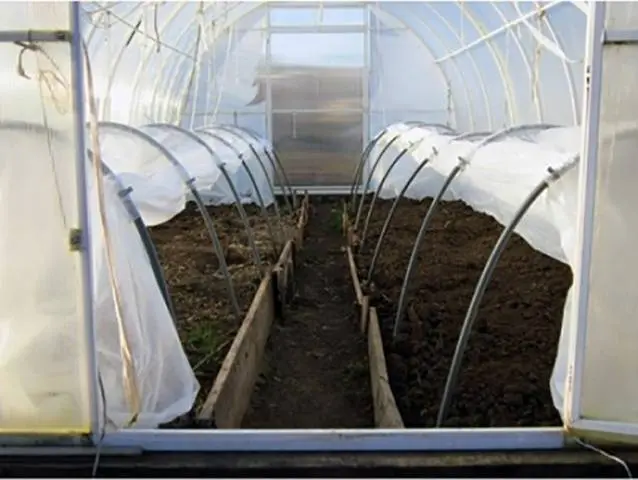
The greenhouse model is completed with 7 arcs made of HDPE pipes with a cross section of 20 mm. In the assembled state, the length of the shelter is 6 m, and the width is 1,2 m. The set includes 15 pegs 250 mm long, clips for the canvas and SUF-42 spunbond with dimensions of 3×10 m. The model is intended for outdoor use and inside the greenhouse. During installation, the arcs are bent to the required size of a semicircle, and with the help of pegs they are stuck into the ground. The covering sheet on the arches is fixed with clamps, and pressed to the ground with any improvised load.
Independent production of an arc greenhouse
At a home-made design, do-it-yourself arcs for a greenhouse are made from any plastic pipe with a diameter of 20 mm. An elastic metal rod with a cross section of up to 10 mm or a flexible hose is suitable. In the latter version, the strength of the arch is given by reinforcement. To do this, insert a wire with a cross section of 6 mm or a long vine rod into the hose.
Making a homemade greenhouse takes place in the following steps:
- Before making arcs for a greenhouse, you need to decide on their size. The width of the arch is enough 1,2 m. The height depends on the growing crops. For example, for cucumbers, this figure is 80 cm, and for semi-determinant tomatoes – 1,4 m.
- From a board or wooden beam, a rectangular box is made according to the size of the beds. For work it is better to use oak or larch. Such wood is less susceptible to decay. The optimal height of the sides of the box is 150 mm. The finished frame is installed in place of the future beds.

- Arcs made of plastic pipe are very flexible and can bend in strong winds. Strengthening the frame will help to cope with the problem. Two racks are installed in the center of the ends of the box from a bar with a section of 50×50 mm. They are connected to each other with a board. In the resulting crossbar, holes are drilled with a diameter of 2-3 mm more than the thickness of the arcs.

- Pieces of the required length are cut from a plastic pipe, and the crossbar is inserted into each hole. Now it remains to bend arches from them and fix the ends of the pipes to the box. Fixing to the sides of the frame is carried out using clamps screwed with self-tapping screws or perforated metal tape. Alternatively, you can hammer pieces of reinforcement into the ground and put arcs on them.

- According to the size of the ends of the frame with an allowance of 200 mm, 2 fragments are cut out of the covering sheet. The material is fixed to the pipe with plastic clamps. Further, a large piece is cut out of the canvas with an allowance of 500 mm to fit the entire greenhouse. The material is laid out on the frame, fixing to the pipes with clamps. The canvas can be additionally nailed to the upper wooden crossbar through the overhead rail.

The covering sheet is pressed to the ground with any load without sharp edges. Otherwise, during the wind, the material may tear.
The video shows the manufacture of a greenhouse:
User Reviews
The reviews of ordinary people often help to choose the right greenhouse model. Let’s find out what they are talking about on the garden forums now.












